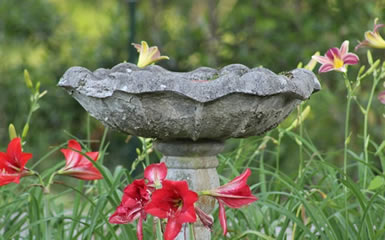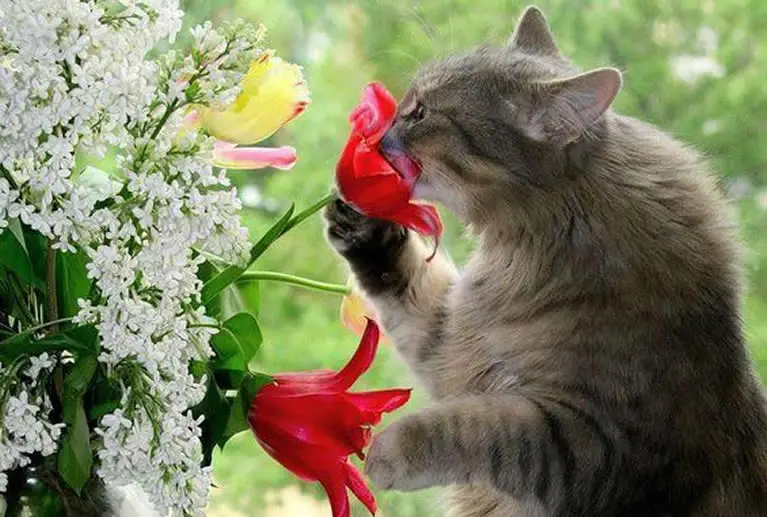Amaryllis is a very popular indoor plant and in some climate zones it is even grown outside. But just because a plant is popular does not mean it is safe, especially when playful children and curious animals like to investigate a plant’s foliage. In this article I will delve deeply into the subject of the safety of amaryllis so you know if amaryllis is poisonous and whether it is safe for you to grow it in your home or garden.
Table of Contents
Are amaryllis poisonous? The truth about the toxicity of this succulent
Popular indoor amaryllis plants come in many different varieties and can be found in homes all across the US.
These succulents are also a popular outdoor garden plant in climate zones 8 through 11.
If you grow amaryllis indoors or outdoors and have heard rumors of its potential toxicity to humans and animals you may be concerned. So, are amaryllis plants poisonous?
Amaryllis are poisonous. Ingesting an amaryllis bulb, leaves or stems will cause severe stomach upset in humans.
Amaryllis is also poisonous to pets and can cause a wide range of symptoms from vomiting, diarrhea and stomach upsets to depression, lack of appetite, tremors and excessive drooling.
For some animals ingesting amaryllis can be deadly.
Amaryllis contains lycorine, a toxic alkaloid, that is poisonous to both humans and pets. Although the most amount of lycroine is found in the bulb, there are still harmful amounts in the leaves and stalks of the plant.
You must be careful with indoor potted amaryllis
Although technically speaking amaryllis has only 2 species, different species of plant in the genus of Amaryllidaceae are often marketed and sold as amaryllis in the US.
There are currently over 1600 plants mistakenly marketed as amaryllis.
With over 1600 different varieties of popular amaryllis it can be difficult to know if your specific plant is poisonous or not.
To be on the safe side, you should consider any plant that is marketed and sold as “amaryllis” to be toxic and poisonous if ingested.
Amaryllis and humans. How safe is this plant for little ones?
Amaryllis is a popular houseplant and although adults are very unlikely to start chewing on its foliage curious children are not as discerning.
With playful children often finding houseplants a great source of curiously it is not unknown for them to chew on foliage to get a sense of how it tastes.
Obviously this is a concern if you have plants that contain toxins. With amaryllis being such a popular houseplant it is wise to wonder if it is poisonous to humans.
The alkaloid lycorine, that is found inside the bulb, leaves and stalks of amaryllis, is poisonous to humans.
If will cause stomach upsets and illness if ingested.
It is completely safe to touch and handle however.
Although adults are unlikely to start munching on the leaves of houseplants, children’s natural curiosity often leads to the “taste test” where they decide chewing on the foliage of a plant sounds like a good idea.
Although many plant leaves and stalks are completely harmless, amaryllis is not one of them.
Ingesting any part of an amaryllis plant will cause stomach upsets and possibly vomiting. Although not fatal the symptoms are very unpleasant.
In homes and areas where children play amaryllis should be grown behind a barrier that children cannot get past or it should not be used at all.
Amaryllis are poisonous to most common pets
It isn’t just playful children that may chew on the foliage of houseplants. Our pets tend to be just as curious around them.
So is amaryllis poisonous to pets?
The bulb, leaves and stalks of amaryllis are poisonous to pets and can cause a wide range of symptoms from vomiting, diarrhea and stomach upsets to depression, lack of appetite, tremors and excessive drooling.
For some small pets amaryllis can be deadly.

Chewing on houseplants can be a favorite pastime for many of our furry friends.
As plant foliage, and grass, act as a natural source of fiber for most animals it is not uncommon for our pets to chew on our indoor plants.
Amaryllis is a not a great plant to grow if you have curious pets that like to investigate your plants.
I own 5 cats (I know crazy cat man) and would never keep indoor amaryllis or grow amaryllis in my garden as two of my cats love nothing more than too eat the “fruits” of my gardening labor.
However, having said that, although amaryllis is poisonous to pets the bitter taste of the plant’s foliage tends to discourage most popular pet species from eating too much of it, i.e. cats and dogs.
One or two nibbles on amaryllis is usually enough to stop a pet from eating any more of it and thus prevents them from ingesting the type of quantities needed to cause serious and concerning problems.
It is still wise to place your amaryllis in areas that you pet you cannot access though, as prevention is always better than cure in my experience.
Of course placing your amaryllis out of the reach of your feline friends may prove more challenging than it would for a dog or other pet.
The toxic relationship between amaryllis and cats
The amaryllis plant is highly toxic to felines but can ingested amaryllis kill cats?
Although amaryllis are poisonous to felines it is unlikely to kill a cat.
The toxic alkaloid lycorine can cause various nasty symptoms in cats but is unlikely to kill them unless it is ingested in large quantities.
Luckily, the taste of amaryllis is unpleasant to cats and this prevents them from consuming large enough quantities to cause death.
Amaryllis is listed as toxic to cats by the ASPCA as the plant contains lycorine, a toxic alkaloid, that can cause quite a severe negative reaction when ingested.
This toxic chemical is most concentrated in the bulb, which a cat is unlikely to bite into, but it is also found in the stalks and the leaves of the plant.
Cats naturally like to eat foliage to deal with hairballs. Anyone who owns a cat knows only too well how they suffer from hairballs.
Hairballs are a direct result from excessive feline grooming. Because cats are groomers and all that licking leads to the accumulations of hair in their stomachs and this hair forms into small balls which could cause blockages if not removed.
Luckily for the cat there is a natural remedy for removing hairballs (apart from making themselves sick).
Although coughing up hairballs is one way to remove them, cats have also evolved to eat grass and plant foliage as it acts as a form of fiber to help move ingested hair through their digestive system for elimination when they use the litter tray.
Houseplants therefore offer a great source of natural fiber for your cat and so this is why it is not unusual for your cat to chew on your indoor plants.
So keeping amaryllis in a home with a cat may not be a great idea.
Unlike dogs, and other pets, it is difficult to move amaryllis to an area that is out of the reach of a cat.
Cats are excellent climbers and exceptional jumpers. So, keeping your poisonous amaryllis away from your feline fur-baby can be almost impossible.
It is slightly fortunate though that cats hate the taste of amaryllis and so it is unlikely a cat will ingest enough of the plant to cause it serious problems.
But it can still eat enough of it, in its initial investigation, to make it sick.

Cats that ingest large enough quantities of amaryllis to cause problems may have any, or all, of the following symptoms:
- Vomiting.
- Diarrhea.
- Stomach upsets.
- Lethargy.
- Depression.
- Lack of appetite or, in extreme cases, anorexia.
- Tremors.
- Drooling.
Should your cat display symptoms of lycorine poisoning, or any other poisoning, you should contact your vet immediately or call the Animal Poison Control Center (APCC) emergency helpline – a division of the ASPCA – at (888) 426-4435 for advice.
Be advised that the APCC charge a consultation fee for this service though they are open 24 hours a day 365 days a year so may be your best option if you encounter a problem when your vet is not available.
Amaryllis is just as toxic to dogs
So amaryllis is probably not the best plant to keep around cats but what about dogs, can amaryllis kill dogs?
Amaryllis contains the toxic chemical alkaloid lycorine which is poisonous to dogs.
However, its bad taste is enough to discourage most dogs from eating large enough quantities of the plant to cause serious illness.
As long as the dog is not allowed to continue eating amaryllis regularly is very unlikely to kill it but may make it very sick.
Dogs that ingest large enough quantities of amaryllis to cause problems may display one or more of the following symptoms:
- Vomiting.
- Diarrhea.
- Stomach upsets.
- Lethargy.
- Depression.
- Lack of appetite or, in extreme cases, anorexia.
- Tremors.
- Excessive drooling.
If you suspect your dog has ingested amaryllis, or it is displaying signs of toxic poisoning, call the ASPCA Animal Poison Control Center emergency hotline at (888) 426-4435 or contact your local vet immediately.
Don’t feed your rabbit amaryllis!
Of course cats and dogs are not the only type of popular pet that can chew on indoor houseplants.
Nor are they the only household animals that also frequent the garden where they can chew on outdoor plants. There are also rabbits. So, are amaryllis poisonous to rabbits?
Amaryllis are poisonous to rabbits.
Although the bulb is the most toxic part of the plant, the foliage also contains the toxic chemical lycorine.
When a rabbit ingests this chemical it will have a serious adverse reaction with various serious symptoms that could even result in death.
Rabbits are much more likely to die from eating amaryllis than other types of pets simply because they are smaller and tend to eat more of the plant than other pets.
Never feed your rabbit amaryllis or leave your rabbit unattended in an area where amaryllis grows.
Of course this advice goes for other popular small herbivore pets as well, such as guinea pigs for example.
Outdoor amaryllis and its affect on wild animals
Outdoor amaryllis may be a bigger cause of concern for householders who want to avoid its poisonous effects on curious wild animals.
In American climate zones 8 through 11 amaryllis is often grown abundantly in gardens.
So some wild animals could be at risk if they venture into your yard and start munching on the foliage.
Let’s look at how amaryllis could be dangerous for other types of animals.
Amaryllis are poisonous to many animals that may venture into your garden
We know that it is not safe for pets to eat amaryllis but what about wild animals that may enter your garden from time to time. Is amaryllis poisonous to all animals?
Amaryllis is poisonous to animals of all kind.
The bulb of the amaryllis plant is the most poisonous to animals as it contains the highest levels of the toxic alkaloid lycorine.
However, smaller amounts of this chemical are also found in the stalks and leaves of the plant.
Larger animals are less likely to die from eating amaryllis but smaller animals may not fare so well.
Amaryllis are poisonous to birds
Birds are found in all gardens and they are difficult to control should they decide to start eating flowers buds.
So, are amaryllis poisonous to birds as well as the other animals I’ve previously mentioned?
Amaryllis are poisonous to birds and cause serious symptoms including vomiting and diarrhea.
Preventative steps must be taken as birds are small animals with small stomachs and digestive symptoms and eating amaryllis can kill them.
Although the most poisonous part of amaryllis is the bulb, the toxic alkaloid lycorine is also evident in all parts of the plant.
A hungry bird will eat flower buds of plants and thus will ingest the toxic chemical if it eats the bud of an amaryllis flower.
Therefore it is best to take protective measures if you grow amaryllis is your garden.
The best way to protect birds from being poisoned from eating amaryllis is to create barriers between plant and bird.
Netting, like this, is probably the most effective way to keep birds away from amaryllis plants (and any other plant you want to protect from bird damage).

You can easily use hoops or similar items to act as a frame for pulling butterfly netting over the plant.
This type of netting is perfect for environmental reasons as the netting protects the plant and, in the case of toxic plants like amaryllis, it also protects the birds from potential poisoning.
The netting prevents the birds from gaining access to the plant while still allowing butterflies and bees easy access to the flowers for much needed pollination.
Amaryllis should not be allowed to grow in horse pens or areas where horses graze
Horses are a common animal found across many areas of the US and so you be wondering if keeping amaryllis around them could be a problem.
Are amaryllis poisonous to horses?
Amaryllis are marked as poisonous to horses by the ASPCA and you should not grow it in areas where your horse is free to feed.
Amaryllis contains the toxic alkaloid lycorine that can cause some nasty symptoms from vomiting and stomach problems to depression, a lack of appetite and tremors.

